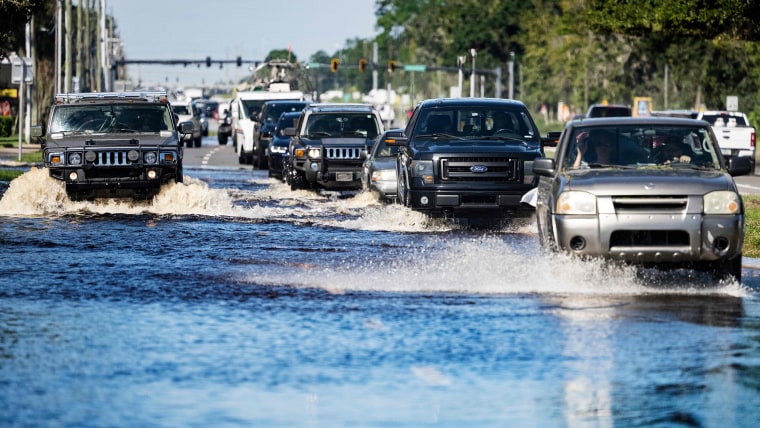By Sarah O'Brien -
CNBC
If you're thinking about buying a used car in the next few months, be sure to check for flood damage before signing the contract.
In the wake of widespread flooding in Florida, North Carolina and South Carolina last month due to Hurricane Ian, the Carfax vehicle reporting website now estimates that as many as
358,000 cars were water damaged
.
Some of these cars will end up being resold, as there are currently an estimated 400,000 water-damaged cars on the roads due to past flooding.
Cars make their way through flood waters as they return to New Smyrna Beach, Florida, on September 30, 2022, after Hurricane Ian hit the area. Jim Watson / AFP via Getty Images
"Flooding causes all kinds of hidden damage, which can come to light months later," said Teresa Murray, consumer watchdog for the Public Interest Research Group of America's Education Fund.
“You don't want to deal with a flooded car, regardless of whether the seller tells you what damage it has and what warranties they offer,” Murray said.
Flooded cars rot inside
Flood water can destroy, sometimes slowly, electronic components, lubricants, and mechanical systems in cars.
Corrosion can get to vital electronic components in the car, including airbag controllers.
“The thing with these flood-damaged vehicles is that they are literally rotting from the inside out,” said Emilie Voss, spokeswoman for Carfax.
Ian's devastation in 7 minutes: this was one of the areas most destroyed by the powerful hurricane
Oct. 8, 202207:41
"They may look good cosmetically, but
there may be mechanical, electrical, safety
and health issues that will show up in the future," Voss added.
Buyers should research the history of the used vehicle to make sure they know what they're buying, no matter when or where they buy, because flooded cars often end up for sale in places far removed from where they were originally damaged.
[Your Money Counts: Three Expert Tips for Buying a Car Amid Inflation]
Through services like Carfax or the National Insurance Crime Bureau's VINCheck, you can enter the vehicle's identification number, or VIN, and see if there's anything in your history that raises a red flag.
These efforts alone, however, may not be decisive.
Not all titles will reflect flood damage
This is because not all flooded cars are recorded as such, unless an insurance company steps in.
When an insurer receives a claim and the vehicle is a total loss (meaning the repairs would cost more than the value of the car), the car's title is usually changed to reflect its condition.
Those wrecked vehicles are often sold at salvage auctions to salvage yards and vehicle rebuilders.
If the title reveals flood damage, you are doing the legally correct thing to do by reselling it to consumers.
[New Car Prices Expected to Drop in US but Interest Rates Are Now Higher]
But not all vehicle owners file an insurance claim.
If they don't have comprehensive coverage, which is the part of auto insurance that includes floods, they're usually out of luck when it comes to coverage.
Therefore, without the insurance company being involved,
there may be no official record of the damage
caused by the flood.
California aims to have only green vehicles by 2035
Sept.
5, 202201:32
“If you suspect a vehicle may have suffered flood damage, come through,” Murray said.
According to Carfax, there are things to look for in a used car that might suggest flood damage:
A musty smell indoors, which sellers sometimes try to cover up with a strong air freshener.
Upholstery or carpeting that may be loose, new, stained or does not match the rest of the interior.
wet carpets
Rust around the doors, under the dash, on the pedals, or inside the hood and trunk latches.
Mud or silt in the glove box or under the seats.
Brittle cables under the dash.
Fog or moisture beads on exterior lights, interior lights, or instrument panel.








